|
Kitchen Designs
Helpful tips to designing a great kitchen:
How to start? Do some careful thinking about your new dream kitchen, and on a piece of paper write down your 'wish' and your 'want' list of ideas. Also, think about your current kitchen and write down what you like about it and what you dislike.
Browse our gallery of kitchen photos and print off any that appeal to you (even if it’s only one thing in the picture you like) and keep these with your notes. That way, you will very quickly build up your ‘kitchen folder’ full of ideas you can refer to when at the designing stage.
Appliances are an important consideration in the kitchen design (and your budget), so think about what appliances you like.
For example:
- Do you like an underbench oven or an elevated oven in an oven tower?
- Double or single oven?
- Do you like the microwave under/on the bench, above the oven, or do you want this in it's own wall cabinet somewhere else in the kitchen?
- What style of rangehood? Do you like retractable, canopy hoods or a concealed type?
- Gas or electric cooktop? The type of cooktop can have an impact on the kitchen design - gas cooktops have different height rules to electric or induction cooktops, and you can get normal 600mm cooktops or wider ones.
Add these notes to your list or ‘kitchen folder’. From this list, nail down the essentials first. Prioritize your likes, as this will make it easier for you at the designing stage.
Tips:
-
Whatever your plan, the sink should take central position if at all possible, as it is used more often than either the refrigerator or the stove. If you locate the sink on the same wall as the stove (with the main work area in the middle), you won't drip water on the floor when you go from the sink to the cooktop. When placing the refrigerator, make sure the single-door model (when open), faces into the work triangle, not out of it.
- Be sure you've allotted ample worktop space right next to any appliance: You'll want to set down heavy grocery bags near the fridge, or stack dishes next to your sink. It is especially important to have enough landing space (an absolute minimum width of 450mm, but preferably 600mm to 900mm) right next to the cooktop, range, oven, and on at least the opening side of the microwave and fridge.
-
Colours, materials and handles are not that important at the initial stage of the kitchen design process, so don’t worry about this yet. You may already have your materials worked out, but if you haven’t yet, that’s OK, as this often comes after the design is done.
Now you are ready to design, or you can employ the services of a local professional kitchen designer in your area to work with you on a design until you are perfectly satisfied.
Once the design is finalised, simply transfer the cabinetry information across to our website for instant pricing.
We hope that this information has been helpful for you.
If you need further help or more information on this topic please:
|
|

